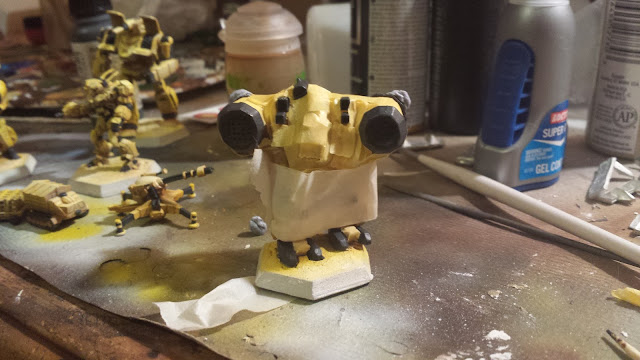Step 9: Wash. Wash, not dunk, and certainly not drown. The color and shading are set, we just want to get some dark into those cracks. With a tiny brush, I carefully inserted Citadel Sepia Shade into the cracks and only into the cracks. This is slow work, but most of the time if you make a mistake (and a watery wash is tough to control) you can brush off the excess with a finger. This step really transforms the mech, and works very, very well with the metal models in particular.
 |
| From left: Hussar, King Crab, Crusader, after the sepia wash. |
 |
| Thumper Artillery |
 |
| The whole family: (from left) King Crab, Stinger, Hussar, Crusader, Bombadier, Wasp, Thumper. |
Step 11a: Masking. A combination of tiny 2mm Tamiya masking tape, regular size masking tape, and bluetac putty to take care of curves.
Almost the entire mech is covered. The masking process took far, far longer than the actual highlighting that follows.
Step 11b: airbrush highlight the second color. For this I used a Barley Gray, and then hit it with a lighter highlight of the same gray mixed with a good bit of white.
Again, drybrushing would have been way faster.
But drybrushing wouldn't have come out like this:
Funny thing about that King Crab: considering how little gray there was to highlight, I intended to just drybrush. I admit, part of that was that I didn't want to go through the hassle of masking. But after I highlighted everything else, I just said "screw it" and freehanded the highlights for the King Crab, Stinger and Wasp without any masking at all. Incredibly, I did so without any mistakes. Ok, there's a slight bit of overspray on one of the mechs, but no one but me will be able to see it unless I tell you which mech and where. It's utterly invisible in the pictures.
 |
| The airbrush allows for a much smoother highlighting on those missile pods and feet. |
I added a few white dots as "lens flares", again with mixed results.
Step 13: Details. Painting missiles white, touches of Steel color, including some drybrushing of places likely to see wear (hands, feet, engines).
I even painted the missiles on the Crusader's collars, which was a bit nutty.
Step 14: Final Drybrush. This is just to bring out the edges for some final highlights. I used Buff, a sort of very light yellow, on the hard yellow edges, and straight White on the gray edges. This is the lightest of light drybrushing. You don't want to see the paint at all, just the illusion of light catching the edges. With the airbrush, the shading and highlighting is as good as I can get it, but this manual step hardens the edges and makes the thing seem like it's 50+ tons of metal.
Step 15: Basing. I simply painted the edges Flat Brown and flocked the base with white glue and Woodland Scenics Summer Grass.
Step 16: Decals. Obviously optional, but the 1st Argyle Rangers are a patriotic bunch. I did this while the flocking was still drying.
Step 17: Final basing touches. Army Painter makes excellent little bushes for basing which are super easy to use. I also have a small container of desert colored stones that go with my color scheme.
Step 18: Sealing. I sealed these with Vallejo Satin Varnish via the airbrush.
And with that, we're done! Take a look at the final product below.
 |
| The Hussar leads the pack. |
 |
| The Longbow, bought entirely because it looks so cool. |
 |
| Wasp. |
 |
| Davion Pride from this King Crab. |
 |
| The Crusader, the mech I'm most looking forward to playing. |
 |
| Back of the Bombadier. |
 |
| Stinger. |
 |
| Back of the Stinger. |
 |
| Thumper Artillery with tracked tow and ammo carrier. |















No comments:
Post a Comment